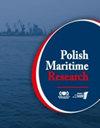船用内燃机和其他船舶动力装置诊断中的量子化问题
IF 2
3区 工程技术
Q2 ENGINEERING, MARINE
引用次数: 0
摘要
摘要 文章证明,船用内燃机和其他船舶动力装置机器的诊断应考虑到某些事件的随机性和不可预测性,如机器运行期间发生的磨损、损坏、机械和热负荷变化等。在本文中,能量 E 与它可以转换成的其他形式(方法)(热量和功)一样,被视为随机变量 Et;在时间 t,该变量的平均值为 E¯t {\bar E_t} ,即能量 E 的观测值。N\left( {E\left( {{E_t}} \right),{{/{sigma _t}})。\over {{sqrt n }}}\right) ,与随机变量 Et 的函数形式无关。证明表明,考虑到船用内燃机或其他船舶动力装置机器执行任务 Z 的时间 t,用上述方法估计的期望值可用来确定机器的可能行动 (DM)。当与执行任务 Z 所需的必要动作 (DW) 相比较时,该可能动作可用于制定有关发动机或相关机器是否能够执行任务 Z 的运行诊断。否则,当 DM < DW 时,该设备无法执行设计和制造阶段所采用的任务,这意味着它处于无能力状态,尽管它仍然可以启动并将能量转换为热量或功的形式。本文章由计算机程序翻译,如有差异,请以英文原文为准。
Quantumness in Diagnostics of Marine Internal Combustion Engines and Other Ship Power Plant Machines
Abstract The article provides proof that the diagnostics of marine internal combustion engines and other ship power plant machines should take into account the randomness and unpredictability of certain events, such as wear, damage, the variations of mechanical and thermal loads, etc., which take place during machine operation. In the article, the energy E, like the other forms (methods) that it can be converted into (heat and work), is considered the random variable Et; at time t, this variable has the mean value E¯t {\bar E_t} , which is the observed value of the statistic E¯st {\bar E_{st}} with an asymptotically normal distribution N(E(Et),σtn) N\left( {E\left( {{E_t}} \right),{{{\sigma _t}} \over {\sqrt n }}} \right) , irrespective of the functional form of the random variable Et. A proof is given that shows that the expected value estimated in the above way, considering the time t of the performance of task Z by a marine internal combustion engine or other ship power plant machine, can be used to determine the machine’s possible action (DM). When compared to the required action (DW) needed for task Z to be performed, this possible action makes it possible to formulate an operating diagnosis concerning whether the engine or machine of concern is able to perform task Z. It is assumed that an energy device of this type is able to perform a given task when the inequality DM≥DW holds. Otherwise, when DM < DW, the device cannot perform the task for which it was adopted in the design and manufacturing phase, which means that it is in the incapability state, although it still can be started and convert energy into the form of heat or work..
求助全文
通过发布文献求助,成功后即可免费获取论文全文。
去求助
来源期刊

Polish Maritime Research
工程技术-工程:海洋
CiteScore
3.70
自引率
45.00%
发文量
20
审稿时长
>12 weeks
期刊介绍:
The scope of the journal covers selected issues related to all phases of product lifecycle and corresponding technologies for offshore floating and fixed structures and their components.
All researchers are invited to submit their original papers for peer review and publications related to methods of the design; production and manufacturing; maintenance and operational processes of such technical items as:
all types of vessels and their equipment,
fixed and floating offshore units and their components,
autonomous underwater vehicle (AUV) and remotely operated vehicle (ROV).
We welcome submissions from these fields in the following technical topics:
ship hydrodynamics: buoyancy and stability; ship resistance and propulsion, etc.,
structural integrity of ship and offshore unit structures: materials; welding; fatigue and fracture, etc.,
marine equipment: ship and offshore unit power plants: overboarding equipment; etc.
 求助内容:
求助内容: 应助结果提醒方式:
应助结果提醒方式:


